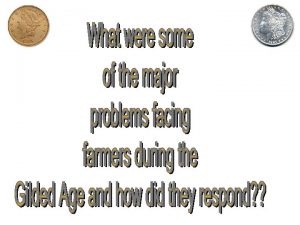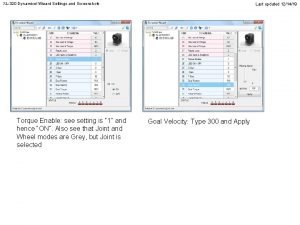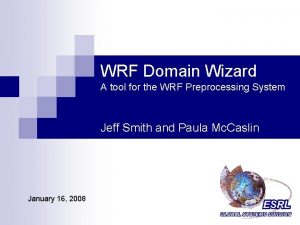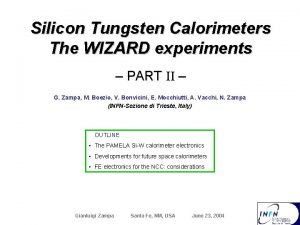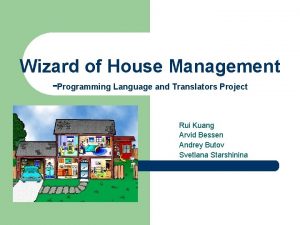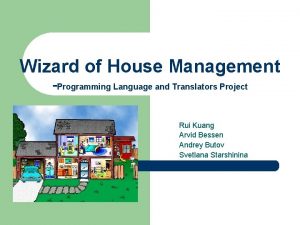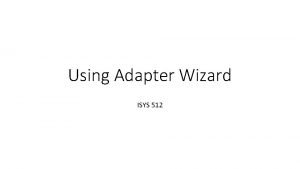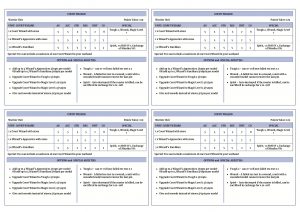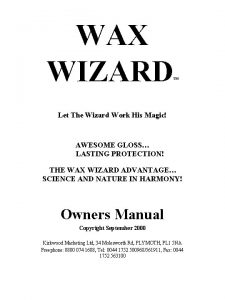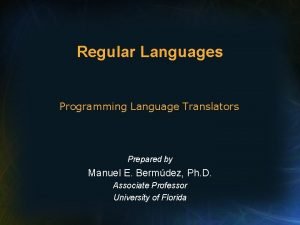Wizard of House Management Programming Language and Translators














![WEM – [W]HOM [EM]ulator l Emulation Features – – – Full display of current WEM – [W]HOM [EM]ulator l Emulation Features – – – Full display of current](https://slidetodoc.com/presentation_image_h2/1afa95e1fa3b23f7486ed7b212081f66/image-15.jpg)





- Slides: 20

Wizard of House Management -Programming Language and Translators Project Rui Kuang Arvid Bessen Andrey Butov Svetlana Starshinina

WHOM l l l A programming language for creation and management of a household Language of the future: expanding the use of computers in our everyday lives Allows automation of tedious tasks

Goals l l l Simple Powerful Event-driven Object-oriented Extendible

What Can WHOM Do? l l l Specify how objects respond to changing conditions (environmental object states) Example: if it rains, close all windows & turn off the sprinklers Another example: if a window is broken, set off the alarm, call the police

Why WHOM? l l Provides easy-to-use event handling, which is important in house manipulation Easy to use even for non-programmers

Syntax and Semantics l l Java-like syntax Basic Types: – – l l number and string realtime and normal Library support with “import” Object-oriented (“class”, “extends”) Static semantics analysis done in both AST walker and backend Error handling class catches all the errors from Lexer, Parser, AST walker and backend to log window for displaying

Recipe l l Import library Class definition – – – l l Attributes (class objects, number or string variables) Methods Inclass events (trigged by hardware) Variable declaration Event implementation – – In-class event Logic condition

Example // foo. wl string msg; class foo{ number foo_num; void who_am_i(void){ msg = "I am the father"; } } class cfoo extends foo{ void who_am_i(void){ msg = "I am the child"; } } //example. whom Import “whom. wl”, “foo. wl”; foo a; cfoo b; once (SECOND == 30){ a. who_am_i(); } once (SECOND == 0){ b. who_am_i(); }

Example import whom. wl; //class specification class Adjustable. Lamp extends Light{ number brightness = 0; void self. Adjust(){ brightness = (LIGHTNESS/10. 0)*3. 0; } EVENT_BUBBLE_DAD; } Adjustable. Lamp lamp; number old. Lightness = 0; once (old. Lightness–LIGHTNESS>4){ lamp. self. Adjust(); old. Lightness = LIGHTNESS; } once lamp. EVENT_BUBBLE_BAD{ lamp. brightness=0; }

The Backend – Main Challenges l l Event-driven Support for complex scoping rules (nested) – – – l l static / global dynamic / stack classes, subclasses Class hierarchy Object-oriented for object-oriented language: Classes corresponding to aspects of the language

Overview – Main Classes l Observable. Object and Event – – l l l Events subscribe to Observable. Objects Subscribers notified if Observable. Object changes Expression and Statement Scopes: Parsing. Scope and Instantiated. Scope Classes

Walking the Tree l l l Get variables / objects for name (existence check) Get methods (dynamic) Construct expressions out of them (type checking) Construct statement out of expressions Statements + scope: block Associate block with surrounding block, method, event, . . .

Execution l l l Variable changes: all events listening to it reevaluate their conditions Condition holds: execute associated block by executing statements, by executing expressions. Nifty features: – – Recursion Subclassing / polymorphism

WHOM Testing l Intended Execution environment: – l Viable solution: – l An embedded system. Software Emulator Testing solution: – WEM & Organized test programs.
![WEM WHOM EMulator l Emulation Features Full display of current WEM – [W]HOM [EM]ulator l Emulation Features – – – Full display of current](https://slidetodoc.com/presentation_image_h2/1afa95e1fa3b23f7486ed7b212081f66/image-15.jpg)
WEM – [W]HOM [EM]ulator l Emulation Features – – – Full display of current state of household. Dynamic update of external variables such as time. Ability to affect the behavior of the system by modifying environment variables.

WEM – Debugging Tools

WEM – Organized Test Programs l Tier 1 – Source parsing & WHOM syntax. – l whitespace parsing, comment parsing… Tier 2 – Backend logic – – – declaration of classes global variables real-time variables conditional statements loops

WEM – Organized Test Programs l Tier 3 – Event logic – – l event logic events triggered by real-time / environment variables Tier 4 – Advanced concepts – – recursion dynamically updated real-time variables

WEM – Organized Test Programs l Toy Box Tier – ‘Hack’ programs – l Temporary programs. If proven useful, will be moved to one of the primary tiers as part of the standard round of testing. Experimental Tier – What If…? – Code which is ‘theoretically’ possible, but useful for no more than personal curiosity.

Lessons Learned l l Everything is more complicated than it appears… But without complexity there is no fun! We had a lot of fun working on WHOM…… (We don’t want to live in an automated house…)
 Translators and facilities of languages
Translators and facilities of languages Translators
Translators Language
Language Acceptance house example in india
Acceptance house example in india Perbedaan linear programming dan integer programming
Perbedaan linear programming dan integer programming Greedy algorithm vs dynamic programming
Greedy algorithm vs dynamic programming What is system programming
What is system programming Linear vs integer programming
Linear vs integer programming Definisi integer
Definisi integer The wizard of oz
The wizard of oz The wizard of oz and the populist party answers
The wizard of oz and the populist party answers Snug bugs home
Snug bugs home Banished boarding house
Banished boarding house My house shall be called a house of prayer
My house shall be called a house of prayer They went house to house
They went house to house Helel keller
Helel keller Dynamixel wizard download
Dynamixel wizard download Domain wizard wrf
Domain wizard wrf Std wizard
Std wizard Lizard from superworm
Lizard from superworm Mips wizard
Mips wizard










